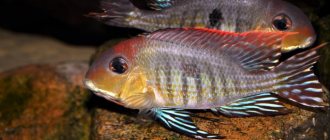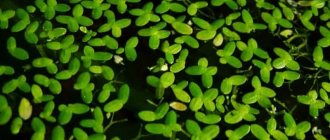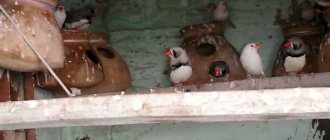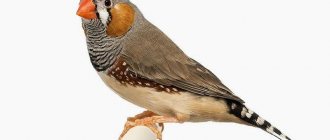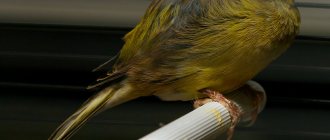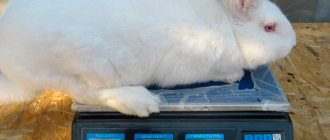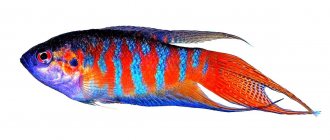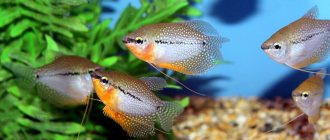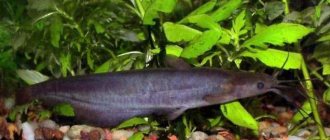Habitat
Ancistrus is native to the Amazon River in South America. It prefers fast-flowing waters of rivers and mountain streams, but can also be found in forest lakes and swamps.
Description
The body of Ancistrus is elongated, teardrop-flattened, covered with bone plates, the head is wide. The mouth is in the shape of a suction cup with peculiar horn-like scrapers, with which the ancistrus scrapes off plaque from snags, leaves and the walls of the aquarium.
The dorsal fin is large, flag-shaped and, in some individuals, pressed to the back. The adipose fin is small, and the ventral and pectoral fins are wide and large.
The color ranges from a yellowish-gray tint to dark gray and even black, the whole body is dotted with light spots. The abdomen is slightly lighter. Juveniles are distinguished by a bluish body color and white edging on the anal and dorsal fins.
A male can be distinguished from a female by the presence of tentacles - leathery processes located on the head, which are absent or almost invisible in females. Males are slimmer and larger and can grow up to 13 cm.
Description of the aquarium fish
The speckled corydor is a small fish: the female grows up to 7 cm in length, and the male up to 4-6 cm. The catfish’s back is convex and covered with a shell consisting of bony plates located on the sides of the body. The body of the fish is gray-olive with multiple black spots, the abdomen has a golden tint. Males have brighter colors than females. The dorsal fin is pointed, unlike the female - she has a rounded fin. With good care, a catfish can live in an aquarium for 8-10 years.
Speckled catfish can be common, veiled and albino, as shown in the photo below:
Aquarium arrangement and maintenance
Ancistrus simplex is quite unpretentious and can be kept in any type of freshwater aquarium with a minimum volume of 50 liters.
A mandatory maintenance condition is the presence of numerous caves, snags and stones, which serve as a shelter and resting place for the fish. Basically, the male chooses one cave he likes and stays close to it, keeping other fish away. Large stones must be stable and lie at the bottom, otherwise the ancistrus may crawl under the stone, which will crush it.
The outlet tubes of the filter should be closed for safety reasons, since the ancistrus, which loves strong currents, can swim too close to them, get into the filter and die.
Ancistrus easily tolerate temperature fluctuations within 17-30°C, but the most comfortable temperature is 22-25°C. РH – 6.5-7.5, dGH – about 15°.
In nature, Ancistrus vulgaris prefers fast-flowing, oxygenated waters, so the aquarium requires powerful filtration with aeration. Partial water changes should be done regularly.
Ancistrus does not like bright light, but due to the fact that it is necessary for plant growth, it is necessary to ensure alternation of light and dark phases with intermediate twilight lighting.
The common ancistrus is very peaceful and can be kept with any fish with similar conditions.
How often do ancistrus lay eggs?
Females of almost any species of fish may not lay eggs for years, until the right moment arrives. First of all, we are talking about the presence of a sexually mature male nearby, capable of fertilizing the eggs, and appropriate conditions suitable for raising offspring.
The only thing that can be said for sure is that the female ancistrus will not lay eggs, being the only representative of its species in the aquarium, since only males care for the eggs of fish of this family.
It takes approximately 3–4 months to form a new batch of eggs after throwing the previous one. Of course, you will not always be able to get these fish to reproduce exactly at the moment when you need them, but below we show how to bring the start of the process as close as possible to the desired date.
Read more about how to grow ancistrus in an aquarium.
Nutrition
In nature and in aquarium conditions, the favorite food of the common ancistrus is the plaque that forms on driftwood, stones and glass, especially if the aquarium is well lit.
In addition, it eats the remains of plant and live food that are not eaten by other fish. When there is a lack of algal growths, it switches to plant leaves, especially young ones, leaving holes on them.
To avoid damage to plants, it is necessary to feed the ancistrus with plant foods: leaves of cabbage, lettuce and nettle scalded with boiling water.
Compatibility with other aquarium fish
Peaceful fish of a similar size are suitable as neighbors. These can be small tetras, livebearers, angelfish, zebrafish, and Sumatran barbs.
Under no circumstances should you plant corydoras with cichlids, labeos and loaches, otherwise they will pluck or kill them.
Reproduction
Doesn't present any particular difficulties. Often, fish are able to lay eggs in a community aquarium, but then the risk of death of the fry is high. The female lays eggs in a secluded place, sometimes even behind or in the filter.
Parental care is mainly provided by the male. From the moment the large orange eggs appear, he fans the eggs with his fins, regularly cleans them with his mouth and protects them from all kinds of enemies, even from the female.
For breeding, it is better to use a separate spawning tank with a volume of 50 liters or more, placing bamboo or ceramic tubes, stones, driftwood, and small clay pots there. To stimulate spawning, water is replaced by a third during a decrease in atmospheric pressure.
Water parameters for dilution: 20-26°C, pH 6-7.3, KH 2°, dH 10°.
The female's readiness for spawning is determined by her rounded abdomen. In some cases, spawning occurs the next day, but generally the male selects a suitable shelter over the course of several days and cleans it thoroughly. During this period, the diet should consist mainly of plant foods.
The female usually spawns at night. The number of eggs can vary from 20 to 300 pieces and depends on its size and age. During the first spawning, the amount of eggs is usually minimal.
The female glues the eggs in the form of a large cluster in a place prepared by the male, and this is where her responsibilities for raising offspring end. She sits down, otherwise the male, protecting the eggs, can seriously harm her. During the period of egg development, which lasts from 4 days to a week depending on the temperature, the male does not leave the eggs even to eat.
If spawning occurs in a common reservoir, the male should be immediately placed in the spawning tank along with the eggs, but only if the female has secured them in some kind of tube or grotto. If the eggs are laid on the glass, they should be carefully removed with a blade, but in this case the male does not need to be transplanted. Having suffered such stress, he will refuse to care for the eggs and may even eat them.
Ancistrus larvae are quite large with large yolk sacs. At first, they remain hanging in a bunch, and only after a few days they gradually spread throughout the aquarium. At this stage, the male leaves and the fry can be fed. Special food for fry and tablets intended for catfish are suitable as starter food. The fry stick to them and slowly chew them off. Finely ground plant food is also suitable.
Ancistrus fry grow very quickly. Feeding should occur at least three times a day, and water should be changed daily by approximately 20%.
At six months, the fry practically catches up with the size of their parents, and by 8-12 months they reach sexual maturity.
With proper care, the common ancistrus (Ancistrus Dolichopterus) lives for about 6 years.
Material 1997, 2013-2014 (previously not published)
Breeding dolichopterus (Bristlenose Plecostomus)
lately is not something supernatural. Catfish successfully spawn, often even in common aquariums for beginners.
However, most often (especially in a community aquarium) it is impossible to predict or control spawning. And in this case, you also need to be able to preserve offspring.
Experienced hobbyists, as a rule, breed catfish in a separate container, recreating the conditions necessary for successful breeding.
ancistrus reproduce , including in my publications . I will not dwell on the classical method of breeding, especially since this common technique has a number of significant disadvantages:
- Fish placed in a spawning area from familiar conditions are forced to undergo a period of acclimatization in new conditions. Therefore, the aquarist must consider the time involved when planning the reproduction of his pets.
- In addition to setting up a holding aquarium and a rearing aquarium for the resulting fry, a third tank is needed. This is actually a spawning ground, which allows you to create and control the conditions necessary specifically for the reproduction of fish. The spawning tank and the nursery are, as a rule, two different containers, since ideally, different conditions are needed for breeding and for the successful rearing of fry. Therefore, here (in addition to the need to contain an additional jar) there is another disadvantage. This is the need to transplant juveniles (or eggs) and the associated risks.
- One of the conditions necessary for successful spawning is the presence of a shelter in which the male makes a nest. But the very presence of a shelter practically eliminates the possibility of control and, in general, any participation on the part of the person who (thinks that he) breeds ancistrus.
In fact, in most cases, the owner of the fish is only a statist, and confirmation of success for him is often the appearance of larvae or fry from the shelter. And this is sometimes 10 days after spawning. When exactly spawning occurred, how many eggs died during incubation and for what reasons, the aquarist most often does not see. And there is no talk at all about intervening in the process if the masonry is threatened.
Of course, you can immediately offer the fish shelter that would allow them to remove the eggs from the general aquarium without harming the eggs (for example, a coconut). In this case, there is no need for a separate spawning tank. Many amateurs do this.
However, here in most cases we will still be deprived of free access and control. Since even simply observing anything inside such a shelter (in a separate spawning area this problem can still be somehow solved) is completely problematic.
Now let's go over again the minimum necessary conditions (and our requirements) for successful controlled breeding of ancistrus:
1. Ancistrus readily reproduce in clean (without suspension), oxygenated water with plenty of feeding.
2. In order for a male to even think about procreation, he needs his own shelter.
Long-term observations allowed me to formulate the basic requirements that males place on their home, and therefore on their future nest. There are only two requirements: the male must fit there entirely (there may not be more space, and it seems that cramped space is more of a plus than a disadvantage for the ancistrus) and there must be an influx of fresh water inside. Shelters located in “dead” zones, where there is no flow and dirt settles, are the last to be chosen by Ancistrus.
Only self-confident males who control their territory think about procreation. Therefore, again, according to my observations, it absolutely does not matter to them how secluded the shelter they choose is, no matter how strange it may sound.
The question of seclusion arises only in the presence of active or aggressive neighbors, as well as in the case of competition between several males. Then the darkness relieves stress, and the narrow entrance helps to maintain defense. But is such a male supposed to reproduce? However, it happens that they spawn in such conditions.
3. We put forward, as a necessary requirement, the ability to freely observe, control and, if necessary, intervene in the process at any moment from spawning to the start of swimming of the fry.
4. In addition, it is extremely important for us that the male choose (and always choose) just such a shelter that we could, without difficulty and risk for himself and his offspring, remove from the aquarium and place in a separate container to protect the fry from possible attacks.
5. And since we have already voiced the need to equip a separate spawning tank as a disadvantage, we simply need to create the necessary conditions and fulfill all the requirements in our common aquarium. This means that we need to solve (if there is) the problem of abundant feeding of future producers, and also eliminate all possibilities of encroachment on eggs, larvae and fry by other inhabitants of the aquarium.
6. Regarding females, everything is simple and no different from the classics (looking ahead): females must be and should be healthy and well-fed.
I wouldn’t be surprised if, after reading the list of necessary conditions, you stop reading this material and yourself recreate everything necessary for the stable and controlled reproduction of your prickly pets.
For those who are interested in ready-made solutions, in continuation of the material I will present my highly complex, innovative “ device ” for breeding ancistrus .
To be continued
Read: Ancistrus breeding technology. Part two
Ancistrus vulgaris
Related posts:
- Breeding technology...
Ancistrus vulgaris
Elliot's cichlazomas. Part 3:...

